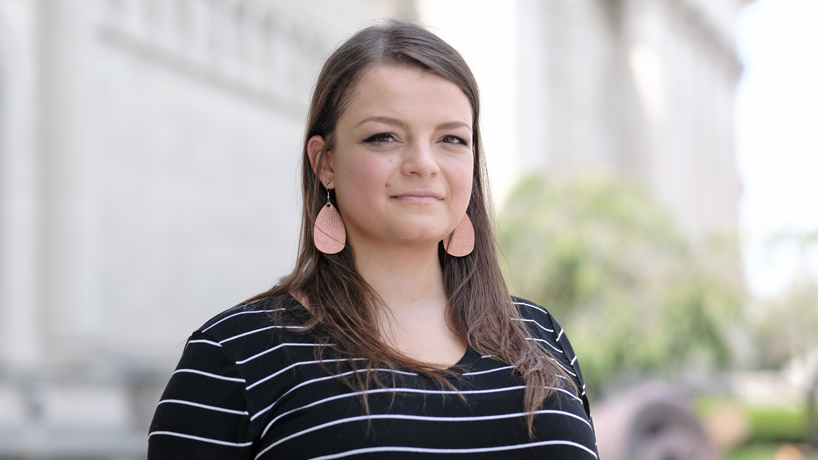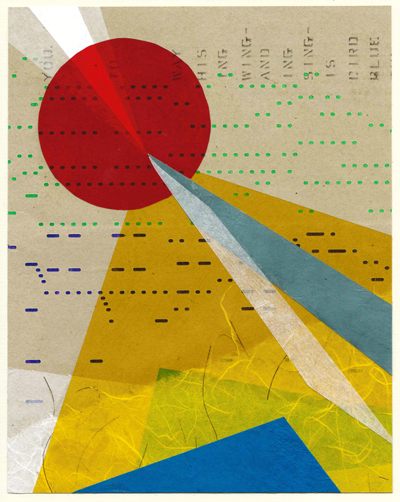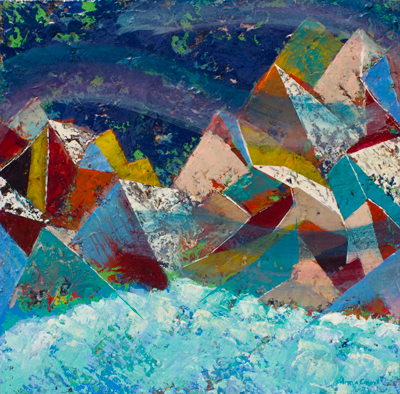
Amela Cikota’s family came to the United States to escape the Bosnian War and made a new home in the St. Louis Bosnian community. Cikota is now a fixture in the community as an art teacher in the Mehlville School District. She’s also a successful artist whose collages and paintings have been exhibited in London and Milan. (Photo by August Jennewein)
When Amela Cikota began first grade in the Mehlville School District, she didn’t know anyone or speak any English.
Like thousands of other Bosnian refugees, her family made its way to St. Louis in the ’90s to avoid the violence of the Bosnian War. A little more than 20 years later, Cikota is at the front of the classroom in the very same school district.
The art educator returned to the halls of the Mehlville School District after graduating from the University of Missouri–St. Louis with a BFA in studio art. In addition to being a teacher, Cikota is also a successful artist whose work has been exhibited internationally in cities such as London and Milan.
Her time at UMSL has made it possible to pursue both paths.
Cikota was born in 1991, a year before the start of the Bosnian War – one of several conflicts leading to the fall of the former Yugoslavia. The next year, her family fled from Bosnia to Germany. They resided there for 4 1/2 years before coming to St. Louis, which had become the unlikely capital of the Bosnian diaspora.
“We came to St. Louis because we already had some family members here,” she said. “It was easier to find a place to get back on your feet.”
At first, it was a difficult adjustment. Cikota spoke Bosnian and German fluently but had to enter an English language learners program at Bernard Elementary.
“First grade was a little rough because of not being able to speak any English,” she recalled. “The other kids noticed that.”
However, one year was all it took to learn the language. She tested out of the ELL program in second grade and made friends in the process. By third grade – around 1999 – more Bosnian kids started attending the school, which resulted in more friendships.
Elementary school was a time of acclimation but also encouragement for Cikota. It’s when her artistic talents first earned recognition.
“When I came here, my art teacher always made my artwork an example for the class and would always praise it,” she said.
Art continued to be her favorite subject in school, but she wasn’t certain about studying it in college. After two years of community college, she decided to study architecture at Southern Illinois University Carbondale.
It didn’t hold her interest, though.
“After a year, I came back to St. Louis,” Cikota said. “I was looking at different art programs, and I wasn’t set on just getting a painting degree or drawing degree. So, I decided to go with art education. I had a creative outlet my whole life, so I wanted to be that opportunity for other kids.”
The art education program at UMSL allowed Cikota to earn a teaching certificate while still developing her skills as an artist, which earned considerable acclaim after her graduation in 2017.
“Code-33” was one of the collages featured in Milan, Italy. Each piece represents a connection between nature and technology. (Artwork courtesy of Amela Cikota)
Her work is primarily inspired by nature and plays with color, perspective and texture. Two projects in particular – a series of collages and a series of abstract landscape paintings – drew the attention of an art gallery curator in Italy.
“She found my website online and contacted me,” Cikota said. “She said, ‘Hey, I think your collages would look really great in this show that I’m curating. Would you be interested?’
“It was so exciting to me because that was my first opportunity at an international show. I immediately jumped at the opportunity, and I ended up having 16 of my collages at a show in Milan.”
The collages featured in the 2018 show were constructed from sheets of a 1918 player piano music roll that Cikota found in an antique store.
“They were really intriguing to me because of the lines and the dots that are punched out that create the song,” she said. “It kind of looks like a code. That’s why the series is called ‘Codes.’ Behind the sheet, I put a colorful piece of paper, so both lines and dots pop. It’s supposed to be like a connection between nature and technology.”
To finish the collages, she layered the sheets with other paper goods such as tracing paper, textured paper and pages from antique books. Each piece used sharp angles and bold colors to form imaginative landscapes.
The next year, a gallery in London showed the collages and abstract landscape paintings.
Amela Cikota’s abstract landscape paintings use bright colors and textures to create a unique representation of nature. (Artwork courtesy of Amela Cikota)
“I always enjoyed drawing and painting landscapes,” Cikota said. “But I wanted to stray away from just painting them realistically. It stemmed from using bright colors you normally wouldn’t see in a regular landscape, playing with the texture of the surface and overlapping the foreground and background.”
While Cikota’s artistic aptitude was always obvious, her teaching presence was less so.
“I had absolutely no experience being around little kids,” she said. “That was the biggest thing. How do I stand in front of 20, 30 kids and not be nervous? The student teaching program, the last year at UMSL, was extremely helpful.”
Now as a full-time art teacher at MOSAIC Elementary School and Oakville Elementary School, she regularly relies on the training she received at UMSL.
“Every time I had to write a lesson plan or talk to parents or talk to my students, I always thought back to what I learned at UMSL,” she said. “It was very rigorous curriculum, and the art education program is very difficult. But I’m glad that it was, because it really did prepare me for my job right now.”
For many students, Cikota is more than a teacher. She’s also a connection to the close-knit St. Louis Bosnian community. It’s a role she cherishes, especially after not having a similar role model as a student.
“A lot of my Bosnian students easily connect with me as soon as they find out I’m Bosnian,” she said. “They want to come to art class. I love it. I absolutely love having Bosnian students. I am able to connect with them because of our culture and can be an informational resource to other students and co-workers about the Bosnian culture.”
















